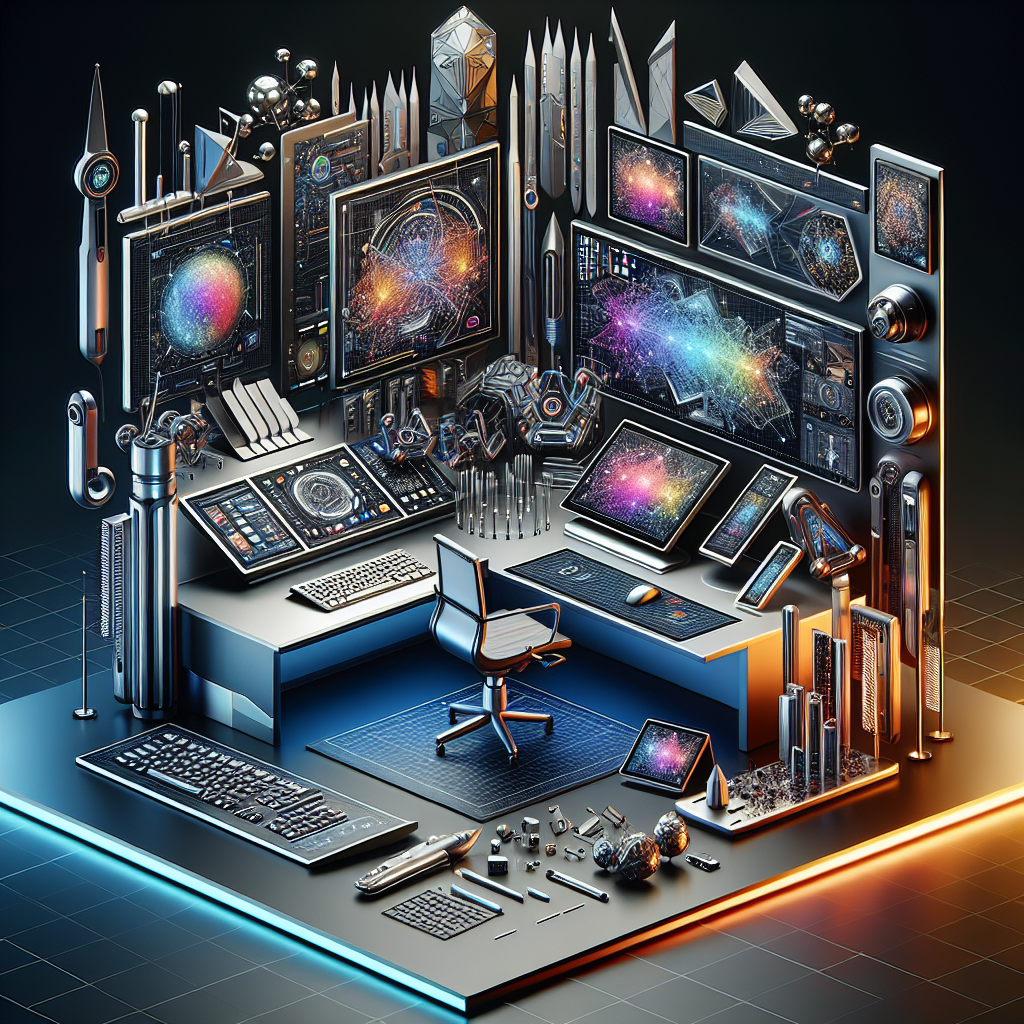
# Outline of the Article:
1. Introduction to 3D Modeling Applications
– What is 3D modeling?
– Importance of 3D modeling applications
2. Overview of Popular 3D Modeling Applications
– Autodesk Maya
– Blender
– SketchUp
– ZBrush
– SolidWorks
3. Features and Capabilities of 3D Modeling Applications
– Modeling tools
– Texturing and materials
– Animation and rigging
– Rendering and visualization
4. Industry Applications of 3D Modeling
– Architecture and interior design
– Film and visual effects
– Gaming and virtual reality
– Product design and prototyping
5. Choosing the Right 3D Modeling Application for Your Needs
– Considerations before selecting an application
– Compatibility and system requirements
– Cost and licensing options
– Learning resources and support
6. Tips for Getting Started with 3D Modeling Applications
– Familiarize yourself with the interface
– Learn essential modeling techniques
– Utilize online tutorials and communities
– Practice and explore different projects
7. The Future of 3D Modeling Applications
– Advancements in real-time rendering
– Integration with AI and machine learning
– Virtual reality and augmented reality capabilities
8. Conclusion
– Recap of the importance and versatility of 3D modeling applications
9. FAQs (five unique FAQs)
# **Application of 3D Modeling: Empowering Creativity and Innovation**
Introduction:
In today’s digital age, the world of design and visual communication has been revolutionized by cutting-edge technologies. One such technology, 3D modeling, has become an essential tool for various industries, enabling professionals to create immersive virtual worlds, stunning graphics, and realistic animations. This article explores the application of 3D modeling and highlights the top industry-leading software available.
1. What is 3D modeling?
– Definition: 3D modeling refers to the process of creating three-dimensional digital representations of objects or environments using specialized software.
– It simulates real-world objects in a virtual space, allowing designers, architects, artists, and engineers to visualize and manipulate their ideas with a high level of precision and realism.
– Unlike traditional 2D drawings, 3D models provide an immersive and interactive experience, enabling better communication of design intent and allowing for accurate prototyping and testing.
2. Overview of Popular 3D Modeling Applications:
a. Autodesk Maya:
– Widely used in the entertainment industry, particularly for film and gaming projects.
– Offers advanced modeling, texturing, and animation tools, making it suitable for creating complex and lifelike characters, environments, and special effects.
– Provides extensive customization options and supports scripting for automation.
b. Blender:
– An open-source 3D modeling application that is free to use.
– Offers a wide range of features, including modeling, sculpting, rigging, animation, and rendering capabilities.
– Has a strong community support and regular updates, making it a popular choice for independent artists and hobbyists.
c. SketchUp:
– A user-friendly 3D modeling application that caters to architects, interior designers, and urban planners.
– Known for its intuitive interface and easy-to-use tools, making it accessible to beginners.
– Offers a vast library of pre-built 3D models and plugins for additional functionality.
d. ZBrush:
– Primarily used for digital sculpting and character design.
– Provides powerful sculpting and texturing tools, allowing artists to create highly detailed and organic models.
– Widely used in the gaming and film industry for creating visually stunning characters and creatures.
e. SolidWorks:
– Popular among engineers and product designers, particularly in the manufacturing industry.
– Provides specialized features and functionalities for parametric modeling, sheet metal design, and assembly modeling.
– Focuses on accuracy and precision, making it suitable for creating complex mechanical parts and assemblies.
3. Features and Capabilities of 3D Modeling Applications:
a. Modeling Tools:
– Common modeling techniques include polygonal modeling, nurbs modeling, and sculpting.
– Application-specific tools vary but generally include extrusion, beveling, subdividing, and boolean operations.
b. Texturing and Materials:
– 3D modeling applications allow users to apply textures and materials to their models, enhancing realism and visual appeal.
– Various mapping techniques, such as UV mapping and procedural textures, are available for achieving desired surface appearances.
c. Animation and Rigging:
– Animation capabilities enable users to bring their models to life by adding movement and dynamics.
– Tools such as keyframe animation, inverse kinematics, and physics simulations enhance the animation workflow.
– Rigging involves the creation of an underlying skeletal structure to control the movement of characters or objects.
d. Rendering and Visualization:
– Advanced rendering engines within 3D modeling applications provide realistic lighting, shading, and rendering options.
– Users can generate high-quality images, animations, and even interactive experiences, facilitating presentations and client interactions.
4. Industry Applications of 3D Modeling:
a. Architecture and Interior Design:
– 3D modeling applications empower architects and interior designers to create virtual representations of their designs.
– Enables clients to visualize spaces, evaluate design aspects, and make informed decisions before construction.
b. Film and Visual Effects:
– 3D modeling applications play a crucial role in creating visual effects for movies, TV shows, and commercials.
– Allows for the creation of realistic digital environments, characters, and dynamic simulations.
c. Gaming and Virtual Reality:
– 3D modeling forms the foundation of the gaming industry, facilitating the creation of virtual worlds, characters, and assets.
– Enables immersive gaming experiences and virtual reality applications by generating interactive and realistic environments.
d. Product Design and Prototyping:
– Industrial designers utilize 3D modeling applications to conceptualize and iterate product designs before production.
– Enables the testing of design functionality and aesthetic appeal, reducing the time and cost required for physical prototyping.
5. Choosing the Right 3D Modeling Application for Your Needs:
– Considerations before selecting an application:
– specific industry requirements, skills and experience level, expected project complexity, and budget constraints.
– Compatibility and system requirements:
– Ensure the selected application is compatible with your operating system and hardware specifications.
– Cost and licensing options:
– Many applications offer both free and paid versions, with additional features available through subscriptions or one-time payments.
– Learning resources and support:
– Consider the availability of tutorials, online communities, and customer support, as these can significantly aid the learning process.
6. Tips for Getting Started with 3D Modeling Applications:
a. Familiarize yourself with the interface:
– Spend time exploring the various menus, panels, and tools within the chosen application.
– Understanding the interface layout will help you navigate and utilize the software effectively.
b. Learn essential modeling techniques:
– Begin by mastering basic modeling techniques such as extrusion, subdivision, and edge manipulation.
– As you progress, explore advanced tools and workflows to enhance your modeling skills.
c. Utilize online tutorials and communities:
– Online resources, such as video tutorials and forums, provide a wealth of knowledge and guidance for beginners.
– Engage with the 3D modeling community, participate in discussions, and seek feedback on your work to improve.
d. Practice and explore different projects:
– The best way to improve your skills is by practicing regularly and taking on diverse modeling projects.
– Each project will present unique challenges and learning opportunities, allowing you to develop a versatile skill set.
7. The Future of 3D Modeling Applications:
– Advancements in real-time rendering:
– Real-time rendering technologies, such as Unreal Engine and Unity, enable instant visual feedback, making the design process more efficient.
– This trend will continue to evolve, providing increasingly realistic and immersive experiences.
– Integration with AI and machine learning:
– AI and machine learning algorithms can assist in automating certain aspects of the modeling process, such as generating initial shapes or optimizing models for specific objectives.
– This integration will enhance productivity and expand the creative possibilities of 3D modeling.
– Virtual reality and augmented reality capabilities:
– 3D modeling applications are increasingly integrating with VR and AR technologies, allowing designers and users to interact with virtual models in a more intuitive and immersive way.
– This integration will shape the future of visualization, collaboration, and user experience design.
Conclusion:
In conclusion, 3D modeling applications have revolutionized the way we create, design, and innovate across various industries. From architects and designers to animators and engineers, these tools empower professionals with the capabilities to visualize ideas, communicate effectively, and bring their imagination to life. As technology continues to advance, the potential of 3D modeling applications will only expand, promising a future marked by further creativity and innovation.
**FAQs:**
1. Q: Are there any free 3D modeling applications available for beginners?
– A: Yes, applications like Blender and SketchUp offer free versions with robust features suitable for beginners.
2. Q: Can 3D modeling applications be used for prototyping objects for 3D printing?
– A: Absolutely, most applications provide tools for preparing 3D models for 3D printing, ensuring accurate and successful prints.
3. Q: Which industries benefit the most from 3D modeling applications?
– A: Industries such as architecture, film and visual effects, gaming, and product design heavily rely on 3D modeling applications for their respective needs.
4. Q: Are there online courses available to learn 3D modeling?
– A: Yes, numerous online platforms offer comprehensive courses and tutorials, catering to all skill levels, making it accessible for anyone interested in learning 3D modeling.
5. Q: Can 3D modeling applications be used on mobile devices?
– A: Yes, some applications have mobile versions available, allowing users to create and edit 3D models on smartphones and tablets.



